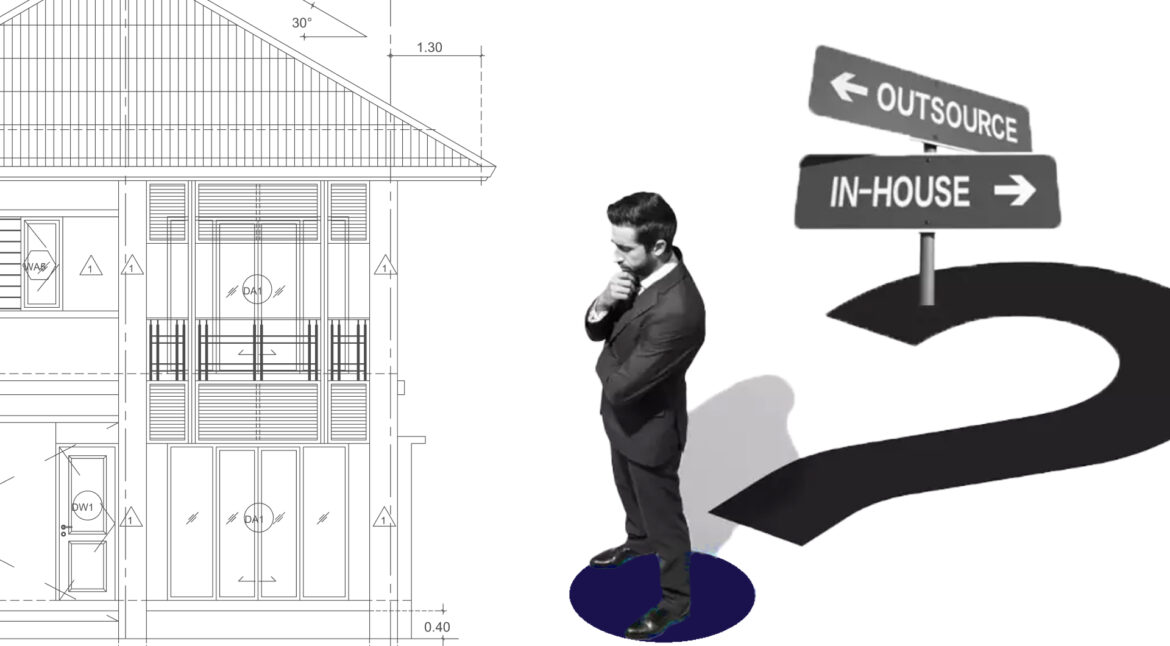When businesses choose between outsourcing CAD drafting services or keeping an in-house team, they face an important decision that can affect both costs and efficiency. With new technology changing how designs are made, it’s more important than ever to carefully consider the benefits and downsides of each option. In this blog, we will look at the main factors to think about when deciding whether to outsource 2D drafting or keep it in-house, using information from industry trends, cost studies, and new drafting technologies.
Understanding CAD Drafting – What It Is and Why It Matters
Computer-aided Design and Drafting is the process of creating detailed technical drawings and schematics through the use of specialized software. Unlike traditional methods which rely on manual tools like pencils and paper. CAD drawings enable precision, speed, and efficiency in producing designs used across a wide array of industries—from architecture and construction to manufacturing and even the arts.
CAD drafting, including the creation of CAD As-built Drawings, serves as the backbone for engineers, architects, and designers to visualize ideas, plan projects, and communicate technical specifications. The demand for quality CAD work is high, but the decision to keep it in-house or outsource it to external experts can significantly impact your business operations.
Advantages of In-House CAD Drafting
Faster Delivery Time
One of the main advantages of having an in-house CAD team is the ability to respond quickly to last-minute changes and urgent requests. With your own team, you can meet tight deadlines and make design changes right away, making sure client needs are met without the delays that can happen with outside teams.
Control and Security
by having an internal team It gives you full control over the design process. This is important when you need to protect confidential information and ideas. Your internal team follows your company’s security rules. keeping sensitive data and designs safe.
Consistency in Work Quality
Teams work closely with your business’s goals, values, and ways of doing things. This helps in the work they produce is consistent and matches the company’s vision.
Challenges of In-House CAD Drafting
High Operating Costs
Running an in-house CAD team can be costly. In addition to salaries and benefits, businesses need to spend on training, software updates, office space, and technology. CAD software and tools are also expensive and require regular maintenance and upgrades.
Limited Scalability
A downside of internal teams is that they can not easily grow. If your business suddenly needs more work done or requires special skills hiring and training new staff takes time and money. The size of your staff and resources also limits the team’s ability to handle more work.
Recruitment-Retention Issues
It can be hard to find skilled CAD professionals. if your business needs special skills like mechanical design or 3D modeling. Hiring and keeping the right people often takes extra time, effort, and resources.
Advantages of Outsourcing CAD Drafting
Cost-Effectiveness
One of the main benefits of CAD drafting outsourcing is the potential to save money. By outsourcing, businesses can avoid costs like salaries, benefits, and other expenses of having full-time staff. You only pay for the services you need, making it a more flexible and affordable option, especially for companies with changing needs.
Access to Specialized Expertise
Outsourcing gives you the chance to work with experts who have specialized skills. Whether it’s advanced 3D modeling, mechanical design, or architectural rendering. outsourcing lets you hire people with specific knowledge that your team might not have. This is especially useful for short-term projects that need special skills.
Scalability and Flexibility
Outsourcing makes it easier to adjust your CAD capabilities based on your business needs. Whether you suddenly have more projects or need extra help during certain times of the year. outsourcing lets you quickly increase or decrease work without worrying about hiring or firing staff. This flexibility helps businesses stay adaptable in a fast-changing market.
Challenges of Outsourcing CAD Drafting
Communication and Coordination Issues
A big challenge when outsourcing is keeping clear communication with outside teams. Often outsourcing means working with teams in different time zones or locations. which can make managing projects harder and cause delays or confusion. To avoid this, it’s important to set clear communication rules, have realistic expectations, and use tools like Slack, Trello, or Autodesk BIM 360 to work together effectively.
Loss of Control and Oversight
When outsourcing CAD work, companies may find themselves with less direct oversight of the project. Adjusting designs or making last-minute changes can take longer due to communication lags or a lack of direct access to the outsourced team. This could lead to frustrations if the work isn’t meeting your expectations in real time.
Security and Intellectual Property Concerns
Data security is a major concern when CAD drafting outsourcing. Sensitive designs and intellectual property must be protected from unauthorized access. Vetting outsourcing partners for their security practices—such as encryption and non-disclosure agreements is essential to safeguard proprietary information.
Key Considerations for Making the Right Choice
When deciding between outsourcing or maintaining an in-house team, businesses must carefully assess their specific needs. Here are some factors to consider:
Budget and Cost-Effectiveness
If saving money is important, outsourcing is usually the cheaper option. However, businesses that have steady, long-term CAD needs might find it more cost-effective to hire a team to ensure good quality and quick results.
Project Complexity and Specialization
For complex projects that need expert knowledge in specific areas, outsourcing can be a good choice, especially for tasks like CAD to BIM Conversion Services. It gives you access to a wider range of skills and tools without needing to hire full-time staff. However, if your projects are more regular and follow a standard process, an in-house team may provide more consistent results and better alignment with your company’s workflow.
Security and Confidentiality
If it’s important to keep sensitive designs safe, in-house CAD drafting practice is a better choice. When outsourcing, businesses must carefully check the providers and set up strong security measures to protect their intellectual property.
Scalability Needs
Outsourcing offers great flexibility. If your company expects changes in project volume or has busy seasons, outsourcing can provide the extra help you need without the long-term commitment of hiring an internal team.
Speed and Flexibility
In-house teams are faster and more responsive. If you need to meet tight deadlines or make quick design changes, having your own team is usually the best choice. Outsourced teams might not be as quick, especially if they are in different time zones or need extra time for changes.
Conclusion: Making the Right Choice for Your Business
Both in-house and outsourced CAD drawing services have their distinct advantages and drawbacks. The decision hinges on your business’s priorities—whether that’s cost savings, speed, control, scalability, or expertise. By carefully considering the factors above, businesses can make an informed decision that aligns with their operational goals and ensures the successful execution of their CAD projects.
For many a hybrid approach that combines the strengths of in-house teams for core projects. outsourcing for specialized or overflow work may offer the most flexibility and cost-efficiency. Whichever path you choose, it’s crucial to remain adaptable and stay up-to-date with technological advancements to ensure that your 2D drafting operations continue to meet evolving industry demands.



